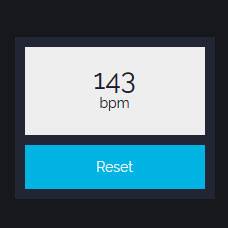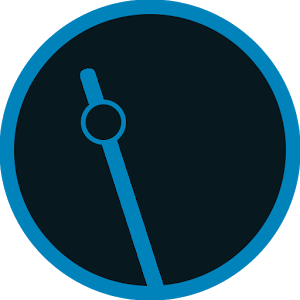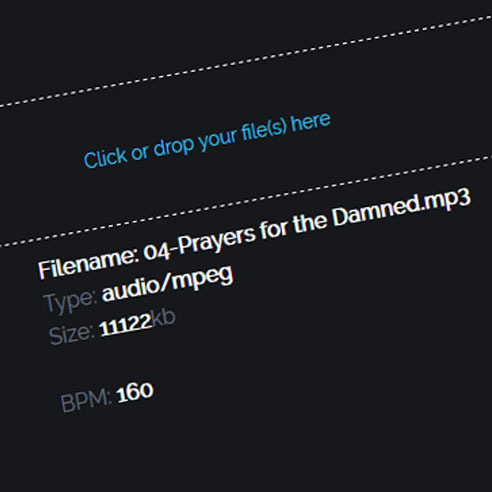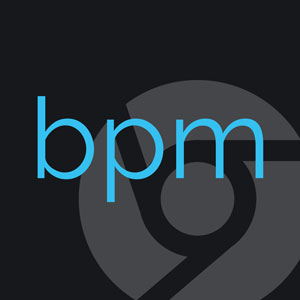Online Metronome Free Flat Pyramid-style online Metronome App using HTML5 Web Audio API.
Using our free Metronome is easy: select a BPM and press ⏎.
You can change the number of beats per measure (from 2 to 12), and/or accent any beat by highlighting its dot at the bottom of the metronome. Pressing shift and + or - at the same time will increase/decrease BPM by 10.
What is a metronome?
A metronome is one incredibly helpful musical device, designed in the early 19th century, and has been broadly used ever since. The basic principle is that it produces “click” sounds in a certain tempo and time signatures, thus helping musicians stay in rhythm. Both time signature and tempo are set by you, so you can practice any song to perfection.
While traditional mechanical metronomes, in addition to clicking sounds, have a visual effect created by a pendulum,
a modern online visual metronome can have flashing lights or other types of visual help.
A web metronome is a free online metronome, and is quite accessible to everyone today - you can search for them on the web with your mac or windows computers, or as an android or iPhone app.
Who is the metronome for?
This tool could be used during practice lessons while playing any musical instrument – most notably used with drum, guitar (bass included), piano, violin, and flute. Whether you are a beginner or an experienced musician, a metronome should be an essential tool for everyone, for it helps quite a bit with staying on beat and feeling all the rhythms of the music.
In addition to setting a certain tempo and time signature and listening to its beats, you can set the time as well (using a timer, of course, thus additionally making a stopwatch redundant) and therefore practice song timings.
Tempo explained
Tempo, as the name suggests, is basically the speed of the beat. Some works may have slower beat, some have faster, and consequently, a musician shall play slower or faster. The tempo is most often represented in beats per minute (bpm), and it can go from about 40 to 200 bpm. Educated musicians will know the tempo from their note sheet, and each tempo has an Italian name, as stated below.
Time signatures
The time signature (or meter/meter signature) is represented in fractions (i.e. ¾) and tells how many beats are in a single bar (the upper number), and the duration of the beat, that is – note value (the lower number). For example, a common time signature is 4/4, which means there will be 4 quarter note beats in a bar (a section) and is counted: one-two-three-four, one-two-three-four… On the other hand, ¾ will have 3 quarter note beats in a bar (traditional waltz, counted as one-two-three, one-two-three, one-two-three…).
Before mentioned time meters (3/4 and 4/4) are simple time signatures and very common, while 9/8 and 12/8 are compound time signatures for they are not so easy to play without proper practice.
Types of measures you can set on the metronome
Modern metronomes can provide four possibilities:
- Tempo (bpm) selection,
- Time signature (meter) selection,
- Note value selection,
- Timer.
You can combine some or all of these at once and get the most from your practice. The most common way is to start with tempo and meter, then, as you improve your skill, you can add note value and timer to perfect your playing. As stated, you can watch the flashing lights on the screen as well, if audio-only is not enough.
There is a variety of great videos that you can watch on the web to better understand some basic metronome uses, but it should be easy enough without them.
Using our online metronome to sharpen up your performance
Stunning in its simplicity, yet indispensable if you want to improve both your timing and your technique, a metronome is the must have practice tool. GetSongBPM's online metronome (or Android App Metronomio) can be with you wherever you are, and will sharpen your performance and help you as you first learn to play a new piece and then get literally up to speed.
Advantages of practicing using a Metronome
Staying consistent
Most beginners find that when they start playing a piece of music, they confidently play the “easy bits” quickly and then slow down as they move through the more complex parts, or those with the more awkward chords. Guitar players will immediately be picturing those Fs or Bs. The trouble is, even as you become more accomplished, bad habits like those can become easily ingrained.
Now from a music theory perspective, practicing long sections of music is not the most effective form of practice anyway, but setting that aside for a moment, whatever you are playing, you need to keep a steady tempo throughout. That does not necessarily mean the right tempo – that can come later. The key at these early stages is consistency, and for that, the metronome has to become your best friend.
Improving technique
Did you know that many sports players use metronomes to improve technique? Footballers, tennis players and golfers all say a metronome is an important practice tool. For the latter, in particular, the logic is plain to see. Even non-golfers know that the key to success in the sport is all about the swing. And a good swing demands good rhythm.
If rhythm is important to sports players, it is absolutely fundamental to musicians. Clearly, if a metronome can improve technique in a motor skill such as golf, which is not rhythm based per se, then it will be even more valuable in another motor skill where rhythm is everything.
Metronome Tips
General Tips
Breaking it down into sections
There's a difference between practicing your skills and rehearsing a piece of music, but nevertheless, many people consider practicing to mean playing through everything they can think of. When you work with a metronome, there is little point in playing long pieces of music. The idea is to break it into distinct sections.
Start slow
One of guitar legend Frank Zappa's most famous pieces is called The Black Page. It is so called because in musical notation, the piece is so tightly packed with notes that there is barely any white paper visible. It has a reputation for being one of the most complex and difficult guitar solos ever. Watch video footage of Zappa playing The Black Page and his fingers are a blur. It is enough to make any guitarist feel a little nauseous and want to take up the tambourine instead.
So how would you go about learning to play a piece like that? Of course, there is only one answer – very slowly. The Black Page appears on Zappa's 1976 album Live in New York at a tempo of 114 BPM. So if you want to try to prove yourself as a guitarist who fears nothing, the first thing you might want to do is set your metronome to 57 BPM and start from there. This allows you to acquaint yourself with the nuances of the piece. In this example, there are extensive tuplets, including some instances of tuplets within tuplets, along with crochet triplets and minim triplets.
With a piece like The Black Page, you might spend weeks, months or years trying to find your way through what Zappa called the “statistical density” of the piece. But the principle applies to any new arrangement you are learning.
Building muscle memory
Starting slowly and then gradually increasing the BPM on your metronome doesn't just help you find your way around a piece from a technical perspective. It also allows you to build what is known as muscle memory. This has nothing to do with memory as such, but is associated with the nerves that surround the muscles that you are putting to use – in the example of a guitar, your fingers.
When you keep repeating the same action, your brain starts to react differently to the familiar movements, anticipating what is going to come and making you move faster and with more confidence and accuracy.
Improving muscle memory to make you a faster and more accomplished musician is one of the reasons it is so important to include short and familiar sections and patterns in your routine. Muscle memory relies on repetition, not experimentation.
Hitting the speed wall
By starting slow and gradually increasing the tempo on your metronome, you will surprise yourself as your playing becomes faster and more accomplished. However, sometimes you will find that you reach a point and can go no further. A little like the experience felt by long distance runners, this is known as hitting the wall.
If you can't get through the speed wall, there is probably a physical reason, and it comes right back down to technique. One of the downsides to starting slow is that you can introduce all sorts of inefficiencies. To use a simple example, a pianist might start lifting his fingers high off the keyboard in between notes. At a slow tempo, that's no problem, but as you speed up, there comes a point when either you have to stop lifting your fingers like that, or you just won't be able to play any quicker.
In that case, the solution is obvious, but usually, it will be something far more nuanced. The good news is that it will still be there, whatever the tempo, so you can slow back down work with a tutor on new techniques.
Tips by Instrument
Metronome with the Guitar
No matter how good a guitar player you are, a metronome will definitely help you improve. There are various possibilities you can exploit.
Apart from keeping you in rhythm, a metronome can also help you with speed. Simply raise bpm by 10 every time you feel like the current tempo is easy enough. This way you can double your playing speed rapidly.
Also, a metronome like this online tool is an incredibly useful tool for practicing riffs and improvisations. Your new solos will be much more accurate - by the book.
For bass guitars, I think words are needless.
Metronome with the piano
If you play the piano and are interested in improving your skill with a metronome that means you're probably going to or have finished musical school. Or you're simply incredibly talented. Either way, playing the piano with a metronome is quite difficult in the beginning, but quite rewarding later on.
When starting, it is a good idea to select a pulse rate between 60 and 100 bpm. It will be difficult to concentrate on both playing and listening to the beat, therefore playing simple tunes with just one hand is recommended.
And you need to count! While used with rhythm instruments, a metronome is mostly a background noise to follow. But with the piano, you must count if you want to improve.
Metronome with the with drums
Where to start? Drummers are essentially metronomes in their bands/orchestras. If you want to be the best, you got to play your drums as precise as a metronome.
Using a metronome is a must for all the stages of your drumming career. In the beginning, you can practice only one hand, then only the other one, then one leg, then the other. When you adapt all your limbs to independent precision, it is time to start combining.
Playing with both arms and both legs simultaneously is difficult enough, but keeping the perfect rhythm is even more difficult. That’s the next step – try and play as precisely as possible.
Later on, you can improve your speed and improvisation skills by raising bpm.
Metronome with the violin
Whilst violinists have perfect pitch, it may sound easy to play alongside metronome, but that’s clearly not the case. Unlike with other instruments, it is almost impossible to look at the violin for a long time while playing. Therefore, one must completely mentally synchronize with the instrument and the metronome, for complete attention is required.
One useful advice would be to keep the metronome close to your other ear since the violin is very close to one already.
In the beginning, you can play the same tone but with different lengths. For example, you can play D over and over again, but start with longer strokes and then make them shorter over time using the same bpm. This will be very useful for precision practice later on.
If you are a proficient violinist, you can use all of the before mentioned suggestions for other instruments.
Metronome with the flute
Flute players usually have a rhythm section behind them every show they play, but for practicing this instrument, a metronome is once again one of the best practicing tools, if not the best.
Since you’re using your hands only, it is a good idea to tap your feet or move your head alongside the metronome beat to create additional “body rhythm” (when not around, your body is the best metronome). This is most recommended with common time signatures, and if you are a beginner, you should definitely start with that. With complex ones, it will be way harder to do that.
Now, with the flute, it may sound that you are in tempo but actually miss it occasionally. To check if you’re really in tempo, you can record while conducting lessons, save the video and watch it later. I would suggest video recording over audio since you may be using body movement as well.
Conclusion: It's all a matter of timing
We have discussed a range of practice techniques, and all of them are things that can be worked on in the comfort of your own home, as long as you have that simple but all important tool. Enjoy your music, and enjoy using the GetSongBPM online metronome.



